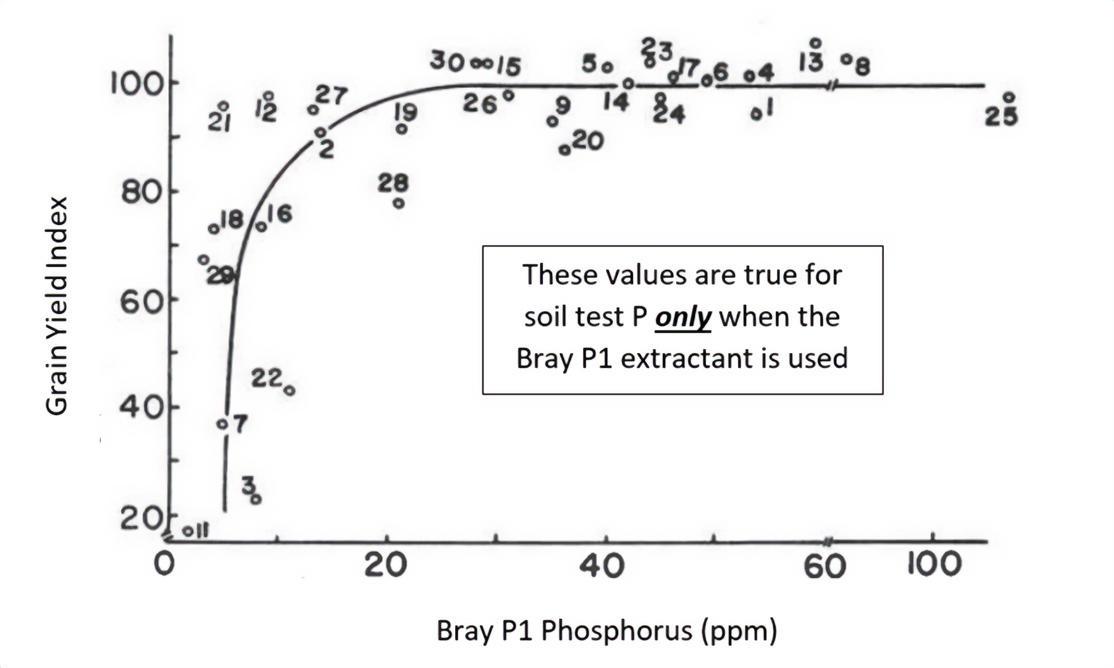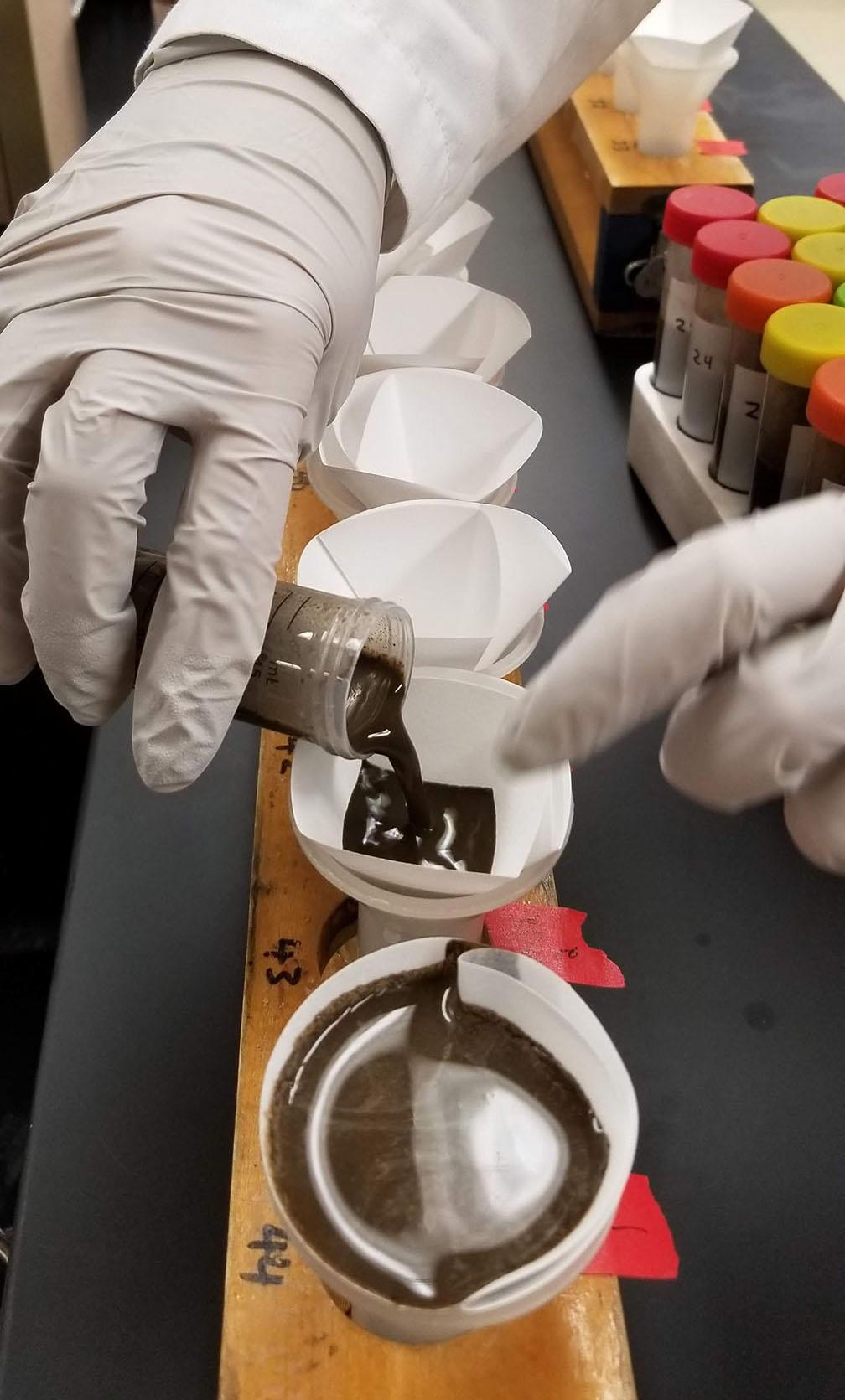Soil testing is an important part of effective nutrient management, whether for backyard gardens or large commercial farms. Soil test information can optimize plant growth while minimizing the environmental impacts of excessive nutrient applications.
However, not all soil tests are the same, and the quality of results varies. In addition, the methods used by soil testing labs are not typically regulated.
Lab customers can ensure they get quality results by researching the lab in advance. Several factors can limit the usefulness of soil test results:
- Poor soil sampling technique.
- Inappropriate testing methods.
- Inaccurate soil testing technique.
- Changes in testing equipment.
Use this guide to select an analytical laboratory for soil nutrient testing. Choose an accredited lab that uses methods calibrated for Oregon soils and adheres to a high standard of quality control. For additional information on how to use the soil test results to make nutrient management decisions, see A Guide to Collecting Soil Samples for Farms and Gardens, EM 628.
Key points
- Choose soil testing methods recommended by Oregon State University.
- Select a soil testing lab that is accredited by the North American Proficiency Testing program or the Agricultural Laboratory Testing Association.
- Speak in advance with lab managers to determine whether their lab is a good fit for your needs.
- Once you select a reliable soil testing lab, try to stay with it as long as possible. Consistently testing at the same lab will allow you to track soil changes over time.
Follow the steps in Figure 1 to receive useful agronomic and nutrient management recommendations:
- Collect a representative soil sample, as described in A Guide to Collecting Soil Samples for Farms and Gardens, EC 628.
- Have the soil sample analyzed by a testing lab using appropriate methods and quality control standards. See the appropriate soil testing methods for Oregon in Tables 1 and 2.
- Compare the test results to calibrated crop responses to determine fertilizer requirements. See Soil Test Interpretation Guide, EC 1479, for details on interpreting test results related to nutrient sufficiency and fertilizer requirements.
Select a lab that uses the appropriate test methods for Oregon
Agronomic soil testing and fertilizer recommendations in the U.S. are based on calibrated yield response curves developed by land grant universities, the USDA Agriculture Research Service and similar institutions. Oregon State University has developed calibrated yield response curves for a wide range of crops and soil test nutrient values over the last century (Figure 2).
These yield response curves define relationships between soil test values and crop yield or crop quality responses that are specific to Oregon. In the example provided in Figure 2, wheat yield increases until soil P is about 25 ppm. Adding P fertilizer beyond that point does not increase yield, but does increase expense and environmental risk.
Tables 1 and 2 list recommended soil test methods for fertilizer and lime applications in Oregon. These methods are calibrated for soils in the Western U.S., with selected methods calibrated specifically for Oregon soils (such as Bray P1 as well as the Sikora and SMP buffer pH methods). Other states recommend different soil testing methods appropriate tor the properties of their soils. Those methods either have not been calibrated to Oregon conditions or have been evaluated but were not adopted due to poor fit.
When using a soil testing lab outside of the Pacific Northwest, select a soil testing package that uses methods calibrated for Oregon soils. Soil test interpretation for Oregon soils may be difficult or impossible for soil tests not included in Tables 1 and 2; select a test package that contains OSU-recommended soil testing methods when possible.
| Soil parameters | Methods | Target regions or soil conditions | Method reference |
|---|---|---|---|
| Soil pH | 1 part soil: 2 parts water (1:2) | All | Miller |
| Buffer pH for lime requirement | Sikora method | Acidic soils, primarily Western Oregon | Crouse |
| Buffer pH for lime requirement | SMP method | Acidic soils, primarily Western Oregon | Miller |
| Extractable phosphorus (P) | Olsen extraction (also known as sodium bicarbonate) | Alkaline soils, primarily Eastern Oregon | Miller |
| Extractable phosphorus (P) | Bray P1 Extraction (1:7) (Also known as Weak Bray or Bray Kurtz P1) | Acidic soils, primarily Western Oregon | Miller |
| Extractable potassium, magnesium, sodium, and calcium (K, Mg, Na and Ca) | Ammonium acetate extraction | All | pH 7.0: Miller pH 8.5: Miller |
| Nitrate-Nitrogen (NO3-N) | Potassium chloride extraction | Low-rainfall climates, primarily Eastern Oregon | Miller |
| Ammonium-Nitrogen (NH4-N) | Potassium chloride extraction | Low-rainfall climates, primarily Eastern Oregon | Miller |
| Sulfate-Sulfur (SO4-S) | Calcium phosphate extraction | Low-rainfall climates, primarily Eastern Oregon | Gelderman |
| Zinc, manganese, copper and iron (Zn, Mn, Cu and Fe) | DTPA extraction | All | Miller |
| Boron (B) | Hot water | All | Miller |
| Soil organic matter (SOM)* | Combustion (derived from total C) | Soils low in carbonates (non-calcareous soils) | Miller |
| Soil organic matter (SOM)* | Walkley-Black | All | Crouse |
| Soil organic matter (SOM)* | Loss on ignition (LOI) | All | Miller |
*See Soil Organic Matter as a Soil Health Indicator: Sampling, Testing, and Interpretation, EM 9251, for more guidance on soil organic matter and soil carbon testing.
| Soil parameters | Method | Target regions or soil conditions | Method reference |
|---|---|---|---|
| Soil texture | Hydrometer | All | Miller et al., 2013. (S – 14.10) |
| Cation-exchange capacity (CEC) and base saturation | Ammonium acetate replacement | All | Miller et al., 2013. (S – 10.10) |
| Electrical conductivity (EC) | 1 part soil: 1 part water (1:1) | Non-saline soils (EC usually below 2.0) | Miller et al., 2013. (S – 2.30) |
| Electrical conductivity (EC) | Saturated paste | Saline soils (EC usually above 2.0) | Miller et al., 2013. (S – 1.20) |
| Soluble potassium, magnesium, sodium, calcium (K, Mg, Na, Ca) and sodium adsorption ratio (SAR) | Saturated paste | All | Miller et al., 2013. (S – 1.60) |
| Chloride (Cl) | Calcium nitrate extraction | All | Miller et al., 2013. (S – 12.10) |
| Nitrogen mineralization potential | Anaerobic 7-day incubation | Soft white winter wheat fields in Western Oregon | Miller et al., 2013. (S – 3.60) |
| Calcium carbonate (CaCO3) | Gravimetric | Calcareous soils, primarily Eastern Oregon | Miller et al., 2013. (S – 13.10) |
Accreditation programs for soil testing labs
Quality control efforts are essential to any soil testing lab to ensure that labs produce consistent and accurate results. Soil testing labs in the U.S. are not mandated to adhere to specific testing protocols, which can introduce error into the results and limit the value of soil test reports for making lime and nutrient management decisions. Labs can be certified annually when they meet specific quality measures through voluntary lab accreditation programs.
The two accreditation programs for soil testing labs in the U.S. are the North American Proficiency Testing – Performance Assessment Program and the Agricultural Laboratory Testing Association – Soil Analysis Certification.
- The NAPT-PAP is managed through the Soil Science Society of America and is often required by Natural Resource Conservation Service cost-share programs that include a nutrient management component. The current list of NAPT-PAP-certified labs is updated annually.
- The ALTA-SAC program is a privately managed certification program that includes soil testing labs primarily from the midwestern U.S. Growers participating in NRCS cost-share programs should first determine whether ALTA-SAC is approved as an accreditation program for their NRCS state unit. The current list of ALTA–SAC-certified labs is updated annually.
Lab certification is based on specific testing methods. These methods may be required by the lab, voluntarily selected by the lab, or both. For example, NAPT-PAP requires pH, EC, buffer pH, P, K, NO3-N and organic matter for the initial performance evaluation and only pH, P, K and NO3-N in subsequent years. For this reason, soil analyses used for accreditation may not be the soil analyses that are recommended for Oregon by OSU. Labs should share which analyses were used for accreditation when requested. This information may not be listed publicly by the accreditation programs.
Alternatively, labs may choose to participate in proficiency testing programs instead of the more rigorous accreditation programs. Proficiency testing programs follow a similar process to the accreditation process described above. However, these programs do not enforce quality control standards and do not mandate corrections. Labs participating in proficiency programs are not accredited. Instead, they receive “program participant” status. The NAPT and Agricultural Laboratory Proficiency programs are the two primary soil testing lab proficiency programs in the U.S. at this time. NAPT is supported by SSSA and ALP is managed through a private company. Proficiency programs can be useful for labs that want to improve soil analysis quality but are typically not approved for NRCS cost-share programs.
Ask questions when choosing a soil testing lab
Gather information about the lab you intend to use to see whether it will be a good fit for your needs. These are important questions to ask the lab before submitting samples:
What method are you using for _________ analysis? Then ask yourself: Is the method recommended for that analysis listed in this publication? If not, what reference is the method based on?
- Why ask this question? Soil testing labs may list an analysis that is recommended by OSU, but may be following a different method and therefore potentially producing different results. Tables 1 and 2 in this publication contain a complete list of OSU-recommended soil testing methods.
Is your NAPT PAP or ALTA accreditation current?
- Why ask this question? Labs with current NAPT PAP or ALTA accreditations indicate that their quality control and quality assurance practices are up-to-date.
Which soil tests are currently accredited through the NAPT-PAP or ALTA programs for your lab? May I see your most recent certification method results?
- Why ask this question? Lab certification is only as good as the methods that were evaluated by the certification program. Do not assume that a lab is certified for OSU-recommended soil testing methods. Take the time to ask lab managers which methods are certified as you evaluate various labs.
May I speak to a lab technician or an agronomist if I have questions about my results?
- Why ask this question? A technician or agronomist on staff with the lab will have more detailed knowledge about the methods that the lab uses than someone external to the lab. They will be in the best position to explain possible reasons for any unusual results. Keep in mind that nutrient management recommendations provided by labs may differ from those provided by land grant universities. Land grant university recommendations are based on regional calibration studies and are generally nonbiased.
What is your protocol if methods or instrumentation change? How do you inform your clients about such changes?
- Why ask this question? New methods or instrumentation can significantly alter soil testing results. Labs should have a plan to address this when they make changes, including notifying all of their clients of the change.
Do you have bulk discounts? What about support for gridded sampling?
- Why ask these questions? Soil analysis becomes more efficient and cost effective as the number of samples increases. Many labs will offer a discount over a certain number of samples. It can be worth asking about large sample number discounts in advance.
What is your turnaround time during the busy season? When is your busy season?
- Why ask this question? To ensure that the turnaround time that the lab provides allows adequate lead time to make decisions about soil-related inputs for the current season.
This process does not guarantee that the lab you choose will be the best fit. If you plan to send many samples to the lab you select, consider sending in an initial small batch of test samples to determine whether that lab is a good fit. Staying with one lab eliminates additional lab-to-lab variability and reduces the potential for confusion when interpreting results.
In summary …
Take the time to select a high-quality soil testing lab that follows OSU-recommended soil testing methods. Soil testing is a worthwhile investment for the future of your land and the success of your crops. The resources and links below will provide you with more information. Contact an OSU Extension professional if you have questions.
Resources and references
- ALP — Agricultural Laboratory Proficiency Program
- Crouse, K.K., D.H. Hardy S. Heckendorn, G. Huluka, D.K. Joines, D.E. Kissel, R. Miller, C.C. Mitchell, K.P. Moore, R. Mylavarapu, J.L. Oldham, T. Provin, H.J. Savoy, F.J. Sikora, L. Sonon, J.J. Wang, D.D. Warncke and H. Zhang. 2014. Soil test methods from the southeastern United States. SERA-IEG-6.
- Diedrick K.A., G. Gao, R.W. Mullen and M.E. Watson. 2017. Guidelines for Choosing a Soil Analytical Laboratory. Ohio State University Factsheet HYG-1133,
- Fery, M., J. Choate and E. Murphy. 2018. A Guide to Collecting Soil Samples for Farms and Gardens, EC 628.
- Gavlak, R., D. Horneck and R.O. Miller, R.O. 2005. Soil, plant and water reference methods for the western region. WREP 125.
- Gelderman, R.H., A.P. Mallarino, T.R. Peck, R. Eliason, J. Peters, M.V. Nathan, C. Laboski, D. Beegle, K. Frank, J.L. Denning, D. Warncke, J.R. Brown, J.R., D.W. Franzen, D.A. Whitney, M.E. Watson, R.J. Goos, S.M. Combs and B. Hoskins. 2015. Recommended chemical soil test procedures for the north central region. NCERA-13.
- Horneck, D., D. Sullivan, J. Owen, and J. Hart. 2011. Soil Test Interpretation Guide, EC 1478.
- Miller R., R. Gavlak and D. Horneck. 2013. Soil, Plant and Water Reference Methods for the Western Region (3rd ed.). WREP-125, WERA-103 Technical Committee.
- NAPT — The North American Proficiency Testing Program
- Sullivan, D.M., N. Andrews, A. Heinrich, E. Peachey, E. and L.J. Brewer. 2019. Soil Nitrate Testing for Willamette Valley Vegetable Production, EM 9221. Oregon State University Extension Service.






